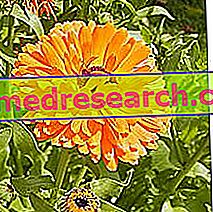
Scientific name
Calendula officinalis L.Family
Asteraceae (Compositae)Origin
Calendula is a typical plant of the Mediterranean region.Used Parts
The drug consists of fully open, whole or dried flowers.Chemical constituents
- Flavonoids (rutinoside, rutin, isoquercetin, narcisin);
- mucilage;
- Cyclic triterpenes;
- Carotenoids (beta-carotene, lycopene, calendulin, lutein and xanthophylls);
- Polysaccharides;
- Phytosterols;
- Essential oil;
- Idrossicumarine.
Calendula in Herbal Medicine: Properties of Calendula
For marigold there are no data that allow its use for oral use, except for what concerns the extracts obtained from flowers, due to their beta-carotene content.
For topical use, calendula has anti-inflammatory, antibacterial, antiviral and immunostimulatory activity, and promotes wound healing with healing activity. Many of the formulations on the market therefore exploit the anti-inflammatory properties for external use (creams and ointments).
Biological activity
Anti-inflammatory and healing properties are ascribed to the calendula. These properties have been confirmed by several studies, so much so that the external use of this plant has been officially approved for the treatment of inflammation of the oropharyngeal cavity and to promote the healing of wounds and burns.
The anti-inflammatory activity is attributable to the triterpenes (in particular, the faradiol and its derivatives) contained in the plant itself.
The healing activity is, instead, exercised by the calendula extract through a mechanism of action that promotes the formation of granulation tissue and promotes the increase of the production of collagen and fibrin.
Moreover, from some studies conducted, calendula has been shown to possess further therapeutic activities.
More in detail, the plant is also endowed with choleretic and antispasmodic properties at the level of the digestive tract, antiviral, antibacterial and even hypolipidemic. This last activity is attributable to the saponosides contained in the calendula, which have shown to be able to reduce both high cholesterol levels and those of triglycerides.
Despite the results obtained, the aforementioned applications of this plant have not been officially approved. However, for more information about the different properties of calendula, see the article on "Calendula - properties and therapeutic indications".
Calendula against inflammation of skin and mucous membranes and to promote wound healing
As mentioned, thanks to the anti-inflammatory and healing properties exerted by the triterpene esters contained within the calendula and its extracts, the use of this plant is widely used to counteract skin inflammation, inflammation of the mucous membranes of the oropharyngeal cavity and to promote healing and the healing of wounds, burns and small burns.
For the treatment of skin inflammations, wounds, burns and burns, calendula is used externally, generally, in the form of creams, ointments or solutions for topical use.
If you use 2-5% calendula ointment, it is usually recommended to apply the product directly on the skin area affected by the lesions several times a day.
For the inflammation of the oropharyngeal cavity, however, the calendula can be taken in the form of an infusion, obtained leaving 1-2 grams of drug in infusion in a cup of water for about 10-15 minutes.
Calendula in folk medicine and in homeopathy
Calendula has always been exploited by folk medicine - both internally and externally - to treat a wide variety of disorders.
When used internally, calendula is used in traditional medicine to treat gastrointestinal ulcers, constipation, dysmenorrhoea and to combat intestinal worm infestations. Furthermore, the plant is also used internally as a diuretic and diaphoretic remedy.
Externally, however, calendula is used by folk medicine to treat some types of vascular disorders, eczema, skin inflammation, proctitis and conjunctivitis, as well as being used as a remedy against bee stings and varicose veins.
Calendula is also used in homeopathic medicine for the treatment of skin diseases such as eczema and acne, to promote the healing of wounds and burns, to treat gingivitis, abscesses, eye irritations and as a remedy against oligomenorrhea, fungal infections vaginal and to promote regularity of menstrual flow.
Generally, the homeopathic calendula remedy can be found in the form of granules, drops, mother tincture or ointments.
The amount of remedy to be taken can vary from individual to individual, also depending on the type of preparation and the homeopathic dilution that you intend to use.
Watch the video
X Watch the video on youtubeSide effects
Calendula is well tolerated; however, sensitization reactions may occur following frequent contact of the plant or its skin preparations.
Furthermore, allergic reactions crossed with other genera of the Compositae family are not uncommon.
Contraindications
Avoid using calendula or its preparations in case of known hypersensitivity to one or more components.
Pharmacological Interactions
- hydroalcoholic extracts of calendula increase the sleep time from barbiturates.



